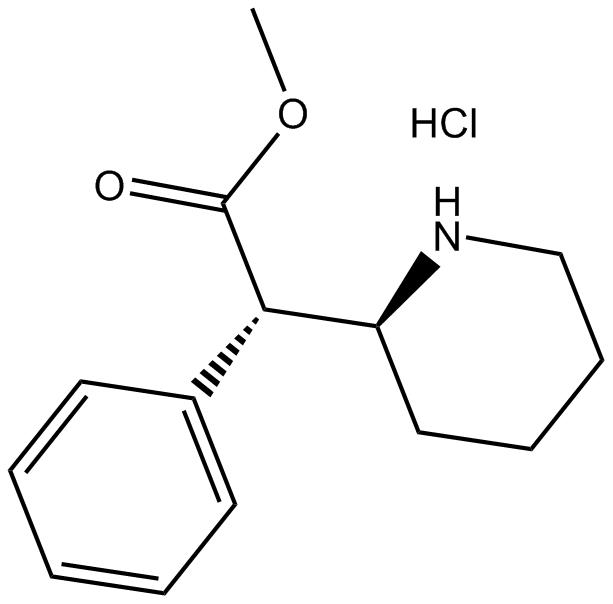Threo-methylphenidate hydrochloride (Synonyms: DL-threo-Methylphenidate, NSC 169868) |
| Catalog No.GC17047 |
Threo-methylphenidate hydrochloride is an inhibitor of dopamine and norepinephrine transporters..
Products are for research use only. Not for human use. We do not sell to patients.

Cas No.: 298-59-9
Sample solution is provided at 25 µL, 10mM.
Threo-methylphenidate hydrochloride is a catecholamine reuptake inhibitor that inhibits dopamine transporter (DAT) and norepinephrine transporter (NET)[1]. Threo-methylphenidate hydrochloride is used to treat attention deficit hyperactivity disorder (ADHD)[2]. Threo-methylphenidate hydrochloride has central nervous system excitability and sympathomimetic effects, and can also affect the cardiovascular system[3].
In vitro, when glial cells were treated with Threo-methylphenidate hydrochloride (100µM, 30 min), a significant increase in [3H]-D-Asp was detected after 2 hours, and this effect persisted after 12hours[4]. The concentration range of Threo-methylphenidate hydrochloride that inhibits NET in HEK293 cells is 0.04-0.42µM, and the concentration range that inhibits DAT is 0.08-0.34µM[5].
In vivo, Threo-methylphenidate hydrochloride(30mg/kg) caused a shortening of the QT interval in the electrocardiogram of beagle dogs and an increase in blood pressure[3]. Threo-methylphenidate hydrochloride(10mg/kg, o.p.) may reduce urine flow and glomerular filtration rate in Wistar rats, but has no harmful effect on renal tubules[6].Threo-methylphenidate hydrochloride(4 mg/kg) increased the anticipatory response of zebrafish in a 5-choice series response task and also increased the overall activity level of the experimental group [7].
References:
Markowitz J S , Patrick K S. Differential Pharmacokinetics and Pharmacodynamics of Methylphenidate Enantiomers[J]. Journal of Clinical Psychopharmacology, 2008, 28: 54-61.
[2]Heal D J , Pierce D M .Methylphenidate and its Isomers: Their Role in the Treatment of Attention-Deficit Hyperactivity Disorder Using a Transdermal Delivery System[J].Cns Drugs, 2006, 20(9):713-738.
[3]Wakamatsu A , Nomura S , Tate Y ,et al. Effects of methylphenidate hydrochloride on the cardiovascular system in vivo and in vitro: A safety pharmacology study[J].Journal of Pharmacological & Toxicological Methods, 2009, 59(3):128-134.
[4]A M. Guillem, Z Martı´nez-Lozada, L C. Herna´ndez-Kell, et al. Methylphenidate Increases Glutamate Uptake in Bergmann Glial Cells[J]. Neurochem Res. 2015(40):2317-2324.
[5]Luethi, D.K., Philine J.Brandt, Simon D. K, et al. Pharmacological profile of methylphenidate-based designer drugs[J].Neuropharmacology, 2018, 134.
[6]Luiza Herbene Macedo Soares Salviano,et al. Study of the safety of methylphenidate: Focus on nephrotoxicity aspects[J].Life Sciences. 2015:137-142.
[7]Parker M O , Brock A J , Sudwarts A ,et al.Atomoxetine reduces anticipatory responding in a 5-choice serial reaction time task for adult zebrafish[J].Psychopharmacology, 2014, 231(13):2671.
Average Rating: 5 (Based on Reviews and 30 reference(s) in Google Scholar.)
GLPBIO products are for RESEARCH USE ONLY. Please make sure your review or question is research based.
Required fields are marked with *




















